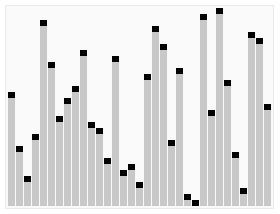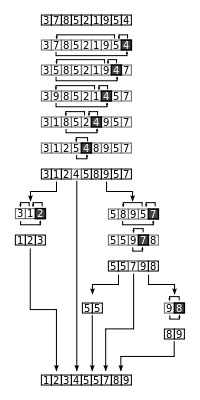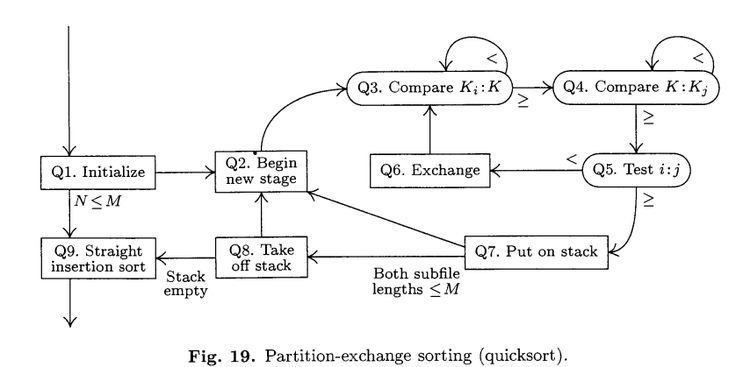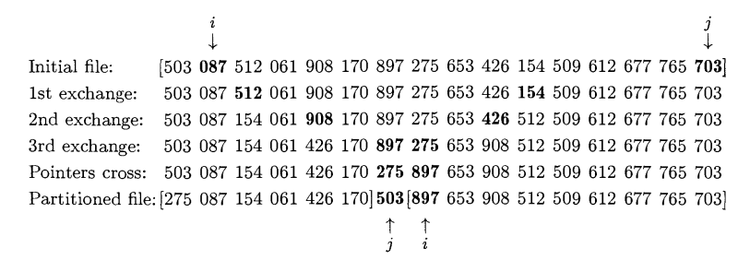Quicksort-2:快速排序-2
Animation

Animated visualization of the quicksort algorithm. The horizontal lines are pivot values.

Full example of quicksort on a random set of numbers. The shaded element is the pivot. It is always chosen as the last element of the partition. However, always choosing the last element in the partition as the pivot in this way results in poor performance (
O(n2)
) on already sorted arrays, or arrays of identical elements. Since sub-arrays of sorted / identical elements crop up a lot towards the end of a sorting procedure on a large set, versions of the quicksort algorithm which choose the pivot as the middle element run much more quickly than the algorithm described in this diagram on large sets of numbers.
Complexity
| Class | Sorting algorithm |
|---|---|
| Data structure | Array |
| Worst case performance | O(n2) |
| Best case performance | O(nlogn) (simple partition) or O(n) (three-way partition and equal keys) |
| Average case performance | O(nlogn) |
| Worst case space complexity | O(n) auxiliary (naive), O(logn) auxiliary (Sedgewick 1978) |
Algorithm Q
Algorithm Q (Quicksort). Records
R1,...,RN
are rearranged in place; after
sorting is complete their keys will be in order,
K1<=...<=KN
. An auxiliary
stack with at most
⌊lgN⌋
entries is needed for temporary storage. This algorithm
follows the quicksort partitioning procedure described in the text above, with
slight modifications for extra efficiency:
a) We assume the presence of artificial keys
K0=−∞
and
KN+1=+∞
such
that
K0<=Ki<=KN+1 for 1<=i<=N . (13)
(Equality is allowed.)
b) Subfiles of
M
or fewer elements are left unsorted until the very end of the
procedure; then a single pass of straight insertion is used to produce the final
ordering. Here
the text below. (This idea, due to R. Sedgewick, saves some of the overhead
that would be necessary if we applied straight insertion directly to each small
subfile, unless locality of reference is significant.)
c) Records with equal keys are exchanged, although it is not strictly necessary
to do so. (This idea, due to R. C. Singleton, keeps the inner loops fast and
helps to split subfiles nearly in half when equal elements are present; see
exercise 18.)
Q1. [Initialize.] If
N<=M
, go to step Q9. Otherwise set the stack empty, and
set
l←1,r←N
.
Q2. [Begin new stage.] (We now wish to sort the subfile
Rl...Rr
; from the
nature of the algorithm, we have
r>=l+M
, and
Kl−1<=Ki<=Kr+1
for
l<=i<=r
.) Set
i←l,j←r+1
; and set
K←Kl
. (The text below discusses
alternative choices for
K
that might be better.)
and
l<=i<j
.) Increase
i
by
Kj>=K
, the iteration must terminate with
i<=j
.)
Q4. [Compare
K:Kj
.] Decrease
j
by
K>=Ki−1
, the iteration must terminate with
j>=i−1
.)
Q5. [Test
i:j
.] (At this point, (14) holds except for
k=i
and
k=j
; also
Ki>=K>=Kj
, and
r>=j>=i−1>=l
.) If
j<=i
, interchange
Rl↔Rj
and
go to step Q7.
Q6. [Exchange.] Interchange
Ri↔Rj
and go back to step Q3.
Q7. [Put on stack.] (Now the subfile
Rl...Rj...Rr
has been partitioned so
that
Kk<=Kj
for
l−1<=k<=j
and
Kj<=Kk
for
j<=k<=r+1
. If
r−j>=j−l>M
, insert
(j+1,r)
on top of the stack, set
r←j−1
, and go
to Q2. lf
j−l>r−j>M
, insert
(l,j−1)
on top of the stack, set
l←j+1
,
and go to Q2. (Each entry
(a,b)
on the stack is a request to sort the subfile
Ra...Rb
at some future time.) Otherwise if
r−j>M>=j−l
, set
l←j+1
and go to Q2; or if
j−l>M>=r−j
, set
r←j−1
and go to Q2.
Q8. [Take off stack.] If the stack is nonempty, remove its top entry
(l′,r′)
, set
l←l′,r←r′
, and return to step Q2.
Q9. [Straight insertion sort.] For
j=2,3,...,N
, if
Kj−1>Kj
do the following
operations: Set
K←Kj,R←Rj,i←j−1
; then set
Ri+1←Ri
and
i←i−1
one or more times until
Ki<=K
; then set
Ri+1←R
. (This
is Algorithm 5.2.1S, modified as suggested in exercise 5.2.1-10 and answer
5.2.1-33. Step Q9 may be omitted if
M=1
. Caution: The final straight
insertion might conceal bugs in steps Q1-Q8; don’t trust an implementation
just because it gives the correct answers!) |
Flow diagram
Data table
Java program
In this program, R1,…,RN were simplified to K1,…,KN.
/**
* Created with IntelliJ IDEA.
* User: 1O1O
* Date: 12/3/13
* Time: 10:01 PM
* :)~
* Quicksort-2:Sorting by Exchanging:Internal Sorting
*/
public class Main {
public static void main(String[] args) {
int N = 16;
int[] K = new int[18];
int[] L = new int[5]; /*Space at most Math.floor(Math.log(N)/Math.log(2))*/
int[] R = new int[5]; /*Space at most Math.floor(Math.log(N)/Math.log(2))*/
int len = 0;
int M = 4;
int temp;
/*Prepare the data*/
K[0] = -10000; /*Negative Infinity*/
K[1] = 503;
K[2] = 87;
K[3] = 512;
K[4] = 61;
K[5] = 908;
K[6] = 170;
K[7] = 897;
K[8] = 275;
K[9] = 653;
K[10] = 426;
K[11] = 154;
K[12] = 509;
K[13] = 612;
K[14] = 677;
K[15] = 765;
K[16] = 703;
K[17] = 10000; /*Positive Infinity*/
/*Output unsorted Ks*/
System.out.println("Unsorted Ks:");
for(int i=1; i<=N; i++){
System.out.println(i+":"+K[i]);
}
System.out.println();
/*Kernel of the Algorithm!*/
int l;
int r;
int i;
int j;
int Key;
boolean stackEmpty = false;
if(N > M){
len = 0;
l = 1;
r = N;
do{
i = l;
j = r+1;
Key = K[l];
do{
do{
i++; /*Q3*/
}while (K[i] < Key);
do{
j--; /*Q4*/
}while (Key < K[j]);
if(j <= i){ /*Q5*/
temp = K[l];
K[l] = K[j];
K[j] = temp;
if(r-j >= j-l && j-l > M){ /*Q7*/
len++;
L[len] = j+1;
R[len] = r;
r = j-1;
break;
}else if(j-l > r-j && r-j > M){
len++;
L[len] = l;
R[len] = j-1;
l = j+1;
break;
}else if(r-j > M && M >= j-l){
l = j+1;
break;
}else if(j-l > M && M >= r-j){
r = j-1;
break;
}
if(len != 0){ /*Q8*/
l = L[len];
r = R[len];
len--;
}else {
stackEmpty = true;
}
break;
}else {
temp = K[i]; /*Q6*/
K[i] = K[j];
K[j] = temp;
}
}while (true);
}while (!stackEmpty);
for(j=2; j<=N; j++){ /*Q9*/
if(K[j-1] > K[j]){
Key = K[j];
i = j-1;
do{
K[i+1] = K[i];
i--;
if(i == 0){
break;
}
}while (K[i] > Key);
K[i+1] = Key;
}
}
}else {
for(j=2; j<=N; j++){ /*Q9*/
if(K[j-1] > K[j]){
Key = K[j];
i = j-1;
do{
K[i+1] = K[i];
i--;
if(i == 0){
break;
}
}while (K[i] > Key);
K[i+1] = Key;
}
}
}
/*Output sorted Ks*/
System.out.println("Sorted Ks:");
for(i=1; i<=N; i++){
System.out.println(i+":"+K[i]);
}
}
}Outputs
Unsorted Ks:
1:503
2:87
3:512
4:61
5:908
6:170
7:897
8:275
9:653
10:426
11:154
12:509
13:612
14:677
15:765
16:703
Sorted Ks:
1:61
2:87
3:154
4:170
5:275
6:426
7:503
8:509
9:512
10:612
11:653
12:677
13:703
14:765
15:897
16:908Reference
<< The art of computer programming: Sorting and Searching >> VOLUME 3, DONALD E. KNUTH
https://en.wikipedia.org/wiki/Quicksort









 本文详细介绍了快速排序算法,包括动画演示、复杂度分析、算法流程、数据表和Java实现。特别指出,选择中间元素作为枢轴可以提高已排序或相同元素数组的排序效率。
本文详细介绍了快速排序算法,包括动画演示、复杂度分析、算法流程、数据表和Java实现。特别指出,选择中间元素作为枢轴可以提高已排序或相同元素数组的排序效率。



















 519
519

 被折叠的 条评论
为什么被折叠?
被折叠的 条评论
为什么被折叠?








